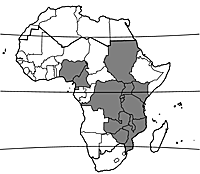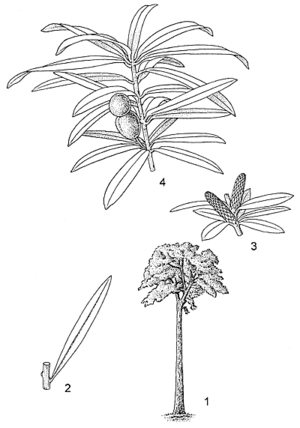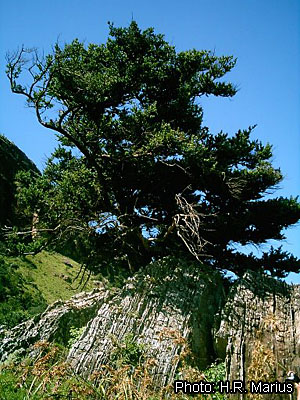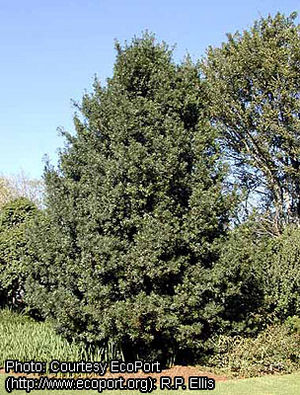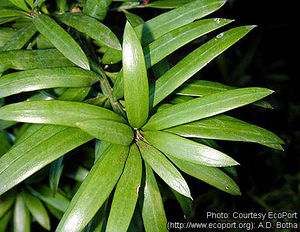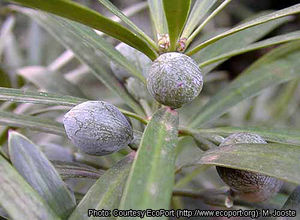Podocarpus latifolius (PROTA)
Introduction |
| General importance | |
| Geographic coverage Africa | |
| Geographic coverage World | |
| Fruit | |
| Medicinal | |
| Timber | |
| Ornamental | |
| Auxiliary plant | |
| Food security | |
| Conservation status | |
Podocarpus latifolius (Thunb.) R.Br. ex Mirb.
- Protologue: Mém. Mus. natl. Hist. nat., Paris 13: 75 (1825).
- Family: Podocarpaceae
Synonyms
- Podocarpus milanjianus Rendle (1894).
Vernacular names
- Real yellowwood, East African yellowwood, broad-leaved yellowwood, red-fruited podo (En).
- Pinho do muxito (Po).
Origin and geographic distribution
Podocarpus latifolius occurs in mountain forest from southern Sudan through eastern Central Africa and East Africa to Zimbabwe, Mozambique, Swaziland and eastern and southern South Africa, where it descends to sea-level. It is also found in the highlands of south-eastern Nigeria and western Cameroon, and has been recorded from an inselberg in Equatorial Guinea. It is occasionally planted as ornamental tree within its natural area of distribution.
Uses
The wood, often traded as ‘podo’, is highly valued for furniture and ship building, e.g. for masts and planks, but it is also used for poles, panelling, boxes, veneer and plywood. It is popular for making butchers’ blocks because it is fairly hard, without scent, and does not chip easily. It is suitable for construction, flooring, joinery, interior trim, vehicle bodies, railway sleepers, toys, novelties, agricultural implements, musical instruments, coffins, food containers, vats, carving, pattern making, matches, turnery, hardboard and particle board. It is also used as fuelwood, and it is considered a high-quality pulpwood.
People occasionally eat the fleshy receptacles at the base of the seeds. In Kenya a bark infusion is taken to treat stomach-ache. In Uganda a leaf decoction is taken as vermifuge. In the Mau region in Kenya the bark is used as waterproof cover for bee-hives. Podocarpus latifolius is planted as ornamental and roadside tree, having a characteristic appearance with its conical shape and bright green glossy leaves, and also as shade tree in coffee, cocoa and banana plantations. It is the national tree of South Africa.
Production and international trade
In the past, the wood of Podocarpus latifolius was in high demand in southern Africa, especially for flooring, furniture and railway sleepers, and it was harvested on a large scale. At present, the international trade in Podocarpus latifolius timber is very limited. In South Africa it has been estimated that on average 750 m³/year of yellowwood roundwood (from Afrocarpus and Podocarpus spp.) is harvested, of which Podocarpus latifolius probably constitutes the major part. The volumes sold by auction in South Africa in 1997 and 1998 were 225 m³ and 260 m³, respectively. There is no information on production and trade from elsewhere, but in many countries illegal logging of this valuable timber species continues.
Properties
The heartwood is pale yellowish brown, and not demarcated from the sapwood. The grain is straight, occasionally spirally, texture fine and even. Reddish streaks of compression wood may be present. Resin is absent, and the wood has no distinctive odour.
The wood is moderately lightweight, with a density of 460–510(–610) kg/m³ at 12% moisture content. It usually air dries without problems, but distortion, end splitting and checking may occur; close stacking and heavy weighting are recommended. Kiln drying should be done at lower temperatures. It has been recommended to air dry for 4–5 weeks, followed by 5–6 days of kiln drying to obtain optimal results. The rates of shrinkage from green to oven dry are 2.0–3.9% radial and 3.7–6.1% tangential. Once dry, the wood is stable in service.
For wood originating from Sudan, at 12% moisture content, the modulus of rupture is 81 N/mm², modulus of elasticity 5100 N/mm², compression parallel to grain 47 N/mm², shear 16 N/mm² and Janka side hardness 6030 N.
The wood is easy to saw and work with machine and hand tools, having little dulling effects on cutting edges. It can be planed to a smooth finish. The wood has a tendency to split upon nailing, and pre-boring is recommended; it holds screws well. It requires support in drilling and mortising because of its brittleness. The gluing, painting, varnishing and staining properties are moderately good. Steam bending gives moderate results, but turning properties are good. The peeling and slicing properties are good; good-quality but brittle veneer can be produced from the wood. The wood is not durable, being susceptible to blue stain, powder-post beetle, pinhole borer, longhorn beetle, termite and marine borer attacks. It is permeable to preservatives. The wood is resistant to acids. The wood of Podocarpus latifolius from Sudan has a high lignin content and was found difficult to pulp.
Several cytotoxic norditerpene dilactones have been isolated from the bark of Podocarpus latifolius, while the lactone inumakilactone B has been isolated from the wood, and heveaflavone, amentoflavone and derivatives from the leaves.
Adulterations and substitutes
The wood of Afrocarpus falcatus (Thunb.) C.N.Page closely resembles that of Podocarpus latifolius and is used for similar purposes; it is also known as yellowwood.
Description
- Evergreen, dioecious, medium-sized to fairly large tree up to 35(–40) m tall, at high altitudes a shrub or small, stunted tree; bole branchless for up to 10(–20) m, usually straight and cylindrical, up to 150(–300) cm in diameter, sometimes with buttresses at base; bark surface greyish brown to dark grey, rather smooth, flaking in long strips, or longitudinally fissured, inner bark pale pink; twigs grooved by decurrent leaf bases.
- Leaves arranged spirally to nearly opposite, simple and entire; stipules absent; petiole indistinct, short; blade linear-elliptical, (2–)3.5–10(–18) cm × 5–12 mm, cuneate at base, acute to acuminate at apex, leathery, glabrous, glaucous green to dark green, with a single main vein and several resin canals.
- Male cone axillary, solitary or more rarely in groups of 2, nearly sessile, 1–5 cm × 3–5 mm, pinkish to reddish; scales many, arranged spirally, each bearing 2 pollen sacs.
- Female cone terminal on short, leafy or scaly branchlet, solitary, with 1–2 fertile scales, at base with swollen, fleshy receptacle 8–18 mm long, glaucous green turning pink to reddish purple or blackish purple.
- Seeds drupe-like, globose to obovoid, 7–12 mm long, glaucous to greyish green, seed coat slightly woody, enclosed in a leathery integument.
Other botanical information
Podocarpus comprises nearly 100 species and is widely spread in the southern hemisphere, extending northward to Central America, southern China and southern Japan. In mainland Africa about 3 species occur, and in Madagascar approximately 5. Afrocarpus has been separated from Podocarpus in 1988, mainly based on the absence of a fleshy receptacle at the base of the seed and on chromosome number, but there is still disagreement about this. However, molecular data support the recognition of Afrocarpus as distinct from Podocarpus.
Podocarpus madagascariensis
Podocarpus madagascariensis Baker is endemic to Madagascar, where it occurs in forest in the mountains at 800–2400 m altitude. It is a small tree up to 15(–30) m tall, with bole up to 30(–60) cm in diameter. The greyish yellow wood is used in local house construction, and for flooring and joinery.
In South Africa there are two other Podocarpus spp., the wood of which is used for similar purposes as that of Podocarpus latifolius: Podocarpus elongatus (Aiton) L’Hér. ex Pers. endemic to the Western Cape, and Podocarpus henkelii Stapf ex Dallim. & A.B.Jacks. endemic to Kwazulu-Natal and the Eastern Cape. Podocarpus ensiculus Melville, described from Tanzania, may be a synonym of Podocarpus henkelii.
Anatomy
Wood-anatomical description (IAWA softwood codes):
- Growth rings: (40: growth ring boundaries distinct); (41: growth ring boundaries indistinct or absent); (43: transition from earlywood to latewood gradual).
- Tracheids: 44: tracheid pitting in radial walls (predominantly) uniseriate (earlywood only); (56: torus present (pits in earlywood tracheids only)).
- Axial parenchyma: 72: axial parenchyma present; (73: axial parenchyma diffuse (evenly scattered throughout the entire growth increment)); 74: axial parenchyma tangentially zonate; 76: transverse end walls smooth.
- Ray composition: (79: ray tracheids commonly present); 80: ray tracheids absent or very rare; 81: cell walls of ray tracheids smooth; 85: end walls of ray parenchyma cells smooth (unpitted); 87: horizontal walls of ray parenchyma cells smooth (unpitted).
- Cross-field pitting: (91: cross-field pits pinoid); (93: cross-field pits cupressoid); 98: 1–3 pits per cross-field (earlywood only).
- Ray size: 103: average ray height medium (5–15 cells); 107: ray width exclusively uniseriate.
Growth and development
Growth of Podocarpus latifolius is slow under natural conditions; for trees with bole diameters between 10 cm and 90 cm, mean diameter increment is 0.2–0.3 cm/year. In cultivation the growth rates are usually also quite low, but they depend on soil fertility and available water. For 32-year-old trees in Rwanda a height growth of 30–56 cm/year has been recorded, and a diameter growth of 4–13 mm/year.
Trees 8–10 m tall may already fruit. In Kenya the fruiting period is in March–April. Monkeys and birds such as hornbills and turacos feed on the fleshy receptacle at the base of the seed, and they usually discard the seed undamaged, serving in this way as dispersers. However, most seed does not get far from the mother tree. Bushpig eat receptacles and seeds after falling. However, it has been reported that seed that has passed the digestive tract of bushpig has a very low germination rate, 2% in comparison with 70% in control seeds. Bee nests are often found in hollow Podocarpus latifolius trees. At higher altitudes, above 2600 m, the trees are usually stunted and rarely taller than 10 m, and often covered with lichens and mosses; on exposed mountain sides, they may be shrubs that barely exceed 2 m in height.
Ecology
In East Africa Podocarpus latifolius occurs in forest in the mountains at 900–3200(–3500) m altitude. It prefers an annual rainfall of 1000–2000 mm and a mean annual temperature of 9–19°C. It is often dominant at higher altitudes in more humid localities, usually preferring sites with higher annual rainfall in comparison with Afrocarpus falcatus. Podocarpus latifolius may be dominant in the climax vegetation of the lower and middle part of the montane zone, together with Olea spp. Locally it occurs in nearly pure stands, especially above 2600 m altitude, and it can also be associated with bamboo. In southern Africa it can be found from sea-level to mountain forest up to 2300 m altitude. In South Africa it is characteristic of the so-called Knysna forest, an evergreen subtropical type of forest of the southern Cape, comprising about 60,000 ha. In Equatorial Guinea Podocarpus latifolius has been found in forest on rocky slopes on an inselberg at 750 m altitude. Podocarpus latifolius is susceptible to drought. It tolerates light frost, but young seedlings are susceptible. It is characterized as a medium shade-tolerant species. It performs best on well-drained, deep, fertile soils. In cultivation it benefits from a layer of mulch on the ground. Studies in South Africa showed that natural regeneration of Podocarpus latifolius is abundant, especially in small and medium-sized gaps in the forest.
Propagation and planting
The 1000-seed weight is 360–600 g. The fleshy receptacle should be removed from the seed. Fresh seeds should be cleaned and sown within 4 days in a mixture of well-rotted compost and washed sand. They germinate in 1–2 months, and the germination rate is up to 80%. Cracking of the seed coat has been recommended to speed up germination. Seeds can be stored in a cold store for up to 1 year without losing much of their germination capacity, but moisture loss should be avoided. Seeds stored in perforated polyethylene bags with damp sawdust showed a germination rate of 72% after one year. When transplanting, care should be taken not to damage the taproot. The seedlings should be well watered. It is recommended to plant in shade and not in the full light, but in a test in South Africa seedlings grown without shade showed the best growth. Wildlings are sometimes also collected for planting.
Management
Young trees up to pole size can be coppiced. In larger trees branches become drooping, and some pruning is often practised. In natural forest in the southern Cape region of South Africa, trees are selectively harvested under a felling cycle of 10 years, and selected according to externally visible criteria of maturity.
Diseases and pests
A canker and die-back disease, known as pink disease and caused by Erythricium salmonicolor has been recorded in South Africa. It affects a wide range of tree species. Seeds are commonly attacked by insects, which may cause considerable losses.
Handling after harvest
Logs are susceptible to insect and fungal attacks and should be removed from the forest and converted as soon as possible after felling, or treated with preservatives. Dipping in an anti-sapstain solution immediately after conversion and before stacking is needed to prevent discoloration by blue stain.
Genetic resources
Podocarpus latifolius is widespread and in many regions within its distribution area quite common. However, it has been subject for many decades to large-scale felling and larger trees have become uncommon. In Rwanda, for instance, Podocarpus latifolius has become quite rare as a result of intensive exploitation. In Zimbabwe it occurs too sparsely to be of any commercial value. Podocarpus latifolius is legally protected in South Africa. It is included in the IUCN Red list, although still considered to be at lower risk.
Prospects
Podocarpus latifolius provides a highly valued timber and as such deserves more research attention. However, its prospects as a plantation timber tree with commercial value, e.g. to substitute exotic pine plantations, seem to be limited because of its low growth rates. The yield from natural forest managed on a sustainable basis is very low.
Major references
- Bolza, E. & Keating, W.G., 1972. African timbers: the properties, uses and characteristics of 700 species. Division of Building Research, CSIRO, Melbourne, Australia. 710 pp.
- Coates Palgrave, K., 1983. Trees of southern Africa. 2nd Edition. Struik Publishers, Cape Town, South Africa. 959 pp.
- Geldenhuys, C.J., 1993. Reproductive biology and population structures of Podocarpus falcatus and P. latifolius in southern Cape forests. Botanical Journal of the Linnean Society 112(1): 59–74.
- Leistner, O.A., 1966. Podocarpaceae. In: Codd, L.E., de Winter, B. & Rycroft, H.B. (Editors). Flora of southern Africa. Volume 1. Botanical Research Institute, Department of Agricultural Technical Services, Pretoria, South Africa. pp. 34–41.
- Maundu, P. & Tengnäs, B. (Editors), 2005. Useful trees and shrubs for Kenya. World Agroforestry Centre - East and Central Africa Regional Programme (ICRAF-ECA), Technical Handbook 35, Nairobi, Kenya. 484 pp.
- Mbuya, L.P., Msanga, H.P., Ruffo, C.K., Birnie, A. & Tengnäs, B., 1994. Useful trees and shrubs for Tanzania: identification, propagation and management for agricultural and pastoral communities. Technical Handbook 6. Regional Soil Conservation Unit/SIDA, Nairobi, Kenya. 542 pp.
- Mtsweni, P., 2005. Podocarpus latifolius. [Internet] South African National Biodiversity Institute, Kirstenbosch, South Africa. http://www.plantzafrica.com/ plantnop/podocarplati.htm. May 2008.
- Palmer, E. & Pitman, N., 1972–1974. Trees of southern Africa, covering all known indigenous species in the Republic of South Africa, South-West Africa, Botswana, Lesotho and Swaziland. 3 volumes. Balkema, Cape Town, South Africa. 2235 pp.
- Sommerlatte, H. & Sommerlatte, M., 1990. A field guide to the trees and shrubs of the Imatong Mountains, southern Sudan. Deutsche Gesellschaft fur Technische Zusammmenarbeit (GTZ), Nairobi, Kenya. 372 pp.
- Takahashi, A., 1978. Compilation of data on the mechanical properties of foreign woods (part 3) Africa. Shimane University, Matsue, Japan, 248 pp.
Other references
- Barker, N.P., Muller, E.M. & Mill, R.R., 2004. A yellowwood by any other name: molecular systematics and the taxonomy of Podocarpus and the Podocarpaceae in southern Africa. South African Journal of Science 100: 629–632.
- Beentje, H.J., 1994. Kenya trees, shrubs and lianas. National Museums of Kenya, Nairobi, Kenya. 722 pp.
- Burkill, H.M., 1997. The useful plants of West Tropical Africa. 2nd Edition. Volume 4, Families M–R. Royal Botanic Gardens, Kew, Richmond, United Kingdom. 969 pp.
- CAB International, 2005. Forestry Compendium. Podocarpus latifolius. [Internet] http://www.cabicompendium.org/ fc/datasheet.asp?ccode=pod_l1&country=0. May 2008.
- de Laubenfels, D.J., 1985. A taxonomic revision of the genus Podocarpus. Blumea 30: 251–278.
- Fozdar, B.I., Khan, S.A. & Shamsuddin, K.M., 1989. Norditerpene dilactones, macrophyllic acid and biflavones from Podocarpus latifolius. Journal of the Indian Chemical Society 66(6): 423–424.
- Guéneau, P., Bedel, J. & Thiel, J., 1970–1975. Bois et essences malgaches. Centre Technique Forestier Tropical, Nogent-sur-Marne, France. 150 pp.
- Hamill, F.A., Apio, S., Mubiru, N.K., Mosango, M., Bukenya-Ziraba, R., Maganyi, O.W. & Soejarto, D.D., 2000. Traditional herbal drugs of southern Uganda, 1. Journal of Ethnopharmacology 70: 281–300.
- Heinz, I., 2004. Systematische Erfassung und Dokumentation der mikroanatomischen Merkmale der Nadelhölzer aus der Klasse der Pinatae. PhD thesis, Technical University Munich, Germany. 209 pp.
- Kabera, I., 1992. Le Podocarpus falcatus, espece indigene prometteuse pour les plantations au Rwanda. Note technique No 7. Institut des Sciences Agronomiques du Rwanda (ISAR), Butare, Rwanda. 45 pp.
- Katende, A.B., Birnie, A. & Tengnäs, B., 1995. Useful trees and shrubs for Uganda: identification, propagation and management for agricultural and pastoral communities. Technical Handbook 10. Regional Soil Conservation Unit, Nairobi, Kenya. 710 pp.
- Lamprecht, H., 1989. Silviculture in the tropics: tropical forest ecosystems and their tree species, possibilities and methods for their long-term utilization. Deutsche Gesellschaft für Technische Zusammenarbeit (GTZ) GmbH, Eschborn, Germany. 296 pp.
- Leistner, O.A., Smith, G.F. & Glen, H.F., 1995. Notes on African plants. Podocarpaceae. Notes on Podocarpus in southern Africa and Madagascar. Bothalia 25(2): 233–236.
- Neuwinger, H.D., 2000. African traditional medicine: a dictionary of plant use and applications. Medpharm Scientific, Stuttgart, Germany. 589 pp.
- Ojiambo, J.A., 1978. The trees of Kenya. Kenya Literature Bureau, Nairobi, Kenya. 105 pp.
- Palmer, E.R., Gibbs, J.A., Ganguli, S. & Dutta, A.P., 1986. Pulping characteristics of Cupressus lusitanica and Podocarpus milanjianus grown in the Sudan. Report L73. Tropical Development and Research Institute, London, United Kingdom. 19 pp.
- Schaefer, C., 1990. Storage and germination of seeds of Podocarpus milanjianus. Technical Note, Kenya Forestry Research Institute No 11. 14 pp.
- Teel, W., 1984. A pocket directory of trees and seeds in Kenya. Kenya Energy Non-Governmental Organisations, Nairobi, Kenya. 151 pp.
- Troupin, G., 1982. Flore des plantes ligneuses du Rwanda. Publication No 21. Institut National de Recherche Scientifique, Butare, Rwanda. 747 pp.
- van Vuuren, N.J.J., Banks, C.H. & Stohr, H.P., 1978. Shrinkage and density of timbers used in the Republic of South Africa. Bulletin No 57. South African Forestry Research Institute, Pretoria, South Africa. 55 pp.
- van Wyk, B.E. & Gericke, N., 2000. People’s plants: a guide to useful plants of southern Africa. Briza Publications, Pretoria, South Africa. 351 pp.
Sources of illustration
- Coates Palgrave, K., 1983. Trees of southern Africa. 2nd Edition. Struik Publishers, Cape Town, South Africa. 959 pp.
- Leistner, O.A., 1966. Podocarpaceae. In: Codd, L.E., de Winter, B. & Rycroft, H.B. (Editors). Flora of southern Africa. Volume 1. Botanical Research Institute, Department of Agricultural Technical Services, Pretoria, South Africa. pp. 34–41.
Author(s)
- J.M. Okeyo, TSBF-CIAT, World Agroforestry Centre (ICRAF), P.O. Box 30677, Gigiri, Nairobi, Kenya
Correct citation of this article
Okeyo, J.M., 2008. Podocarpus latifolius (Thunb.) R.Br. ex Mirb. In: Louppe, D., Oteng-Amoako, A.A. & Brink, M. (Editors). PROTA (Plant Resources of Tropical Africa / Ressources végétales de l’Afrique tropicale), Wageningen, Netherlands. Accessed 22 December 2024.
- See the Prota4U database.

